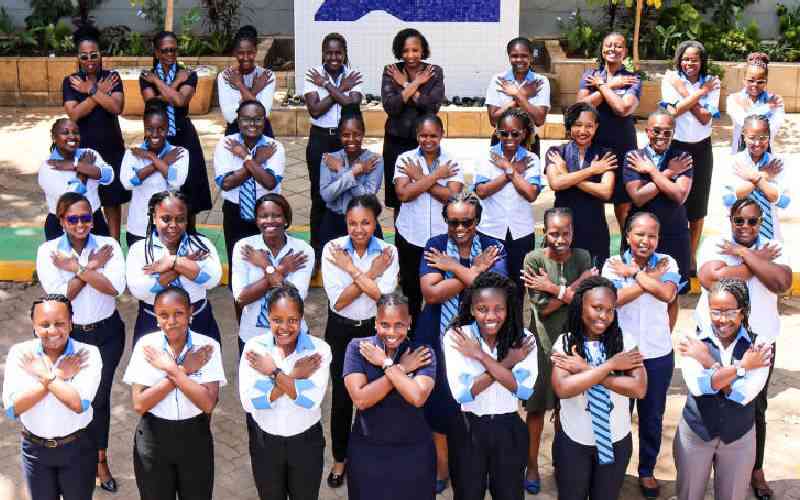Experts have warned that schoolchildren under the age of 16 are developing irreversible back deformities because of the weight of school bags they carry.
In a research paper released Friday by Masinde Muliro University of Science and Technology (MMUST), experts observe that overloaded school bags contribute to a surge in spinal problems among children.
Speaking to the press after the launch, the lead researcher, Dr Peter Bukhala, said backpack weight, type of bag and the distance travelled to and from school affects the body structure of primary school pupils.
The research was carried out in 12 public primary schools in Kakamega Municipality between April and June. A total of 418 pupils were involved.
Permanent damage
“Pupils carry bags filled with heavy books, sweaters, sports kits and packed lunches, which are a half of their total weight. The children risk untimely permanent damage if they continue carrying school bags that weigh more than 15 per cent of their body weight,” said Bukhala.
The research showed that 50 per cent of the pupils carry heavy weights, with 20.5 per cent cases of pupils having back pains being reported.
The experts recommended that the school bags should be wide padded with shoulder strips and also have a waist belt.
Bukhala said a half of all public primary school pupils suffer back pain by the age of 14. He warned that cases of spinal abnormalities in pupils, including disfiguring curvatures, were on the rise.
The experts advise that pupils should not carry bags that weigh more than 15 per cent of their body weight. They however, observed that in most cases, pupils carry up to 30 per cent more than their weight.
At high risk of developing back pains are adolescent girls experiencing rapid spurt growth because they often weigh less than boys but carry the same weight.
Also, children who walk to and from school are more likely to suffer back pain from heavy packs because most schools have no lockers or cupboards for keeping the books.
The average load of Kenyan school bag is between 20-30 per cent of the total weight of the pupils, according to the survey.
Bukhala called for a review of the weights the pupils carry on their backs each day to school, describing the problem as a “healthcare time bomb” if not contained.
“If the pupils are getting back pain at a tender age then there is the potential they will have it for the next 50 to 60 years. Their skeletons are still growing and carrying heavy bags can cause lasting damage,” he warned.
Stay informed. Subscribe to our newsletter
Bukhala further attributed the back problems to lack of adequate desk space for pupils to store heavy books.
“Teachers also contribute to the problem by asking pupils to carry firewood, water and cow dung to school. They reach school when tired and do not concentrate in class, which leads to poor results in exams,” he said.
On the other hand, MMUST Chairman for Sports Science Issah Kweyu asked teachers to strictly follow the school timetable to ensure pupils only come with books for the day’s classes.
He said school heads should make lockers or cupboards where pupils can keep books when going home. Kweyu also asked parents to keep an eye on children’s backpacks so that they do not cause problems on their health.
He told them to always insist that their children pack their bags only with what they need for the next day and ensure they carry the bags on both shoulders.
“Carrying a heavy bag can cause neck, shoulder and back pain which are short-term effects. If this continues, then it can cause scoliosis—the abnormal curve of the spine, which causes persistent back pain,” he said.
Kweyu also advised that teachers and parents start a feeding programme in their schools to ensure pupils take a balanced diet and get ample play time.
 The Standard Group Plc is a
multi-media organization with investments in media platforms spanning newspaper
print operations, television, radio broadcasting, digital and online services. The
Standard Group is recognized as a leading multi-media house in Kenya with a key
influence in matters of national and international interest.
The Standard Group Plc is a
multi-media organization with investments in media platforms spanning newspaper
print operations, television, radio broadcasting, digital and online services. The
Standard Group is recognized as a leading multi-media house in Kenya with a key
influence in matters of national and international interest.
 The Standard Group Plc is a
multi-media organization with investments in media platforms spanning newspaper
print operations, television, radio broadcasting, digital and online services. The
Standard Group is recognized as a leading multi-media house in Kenya with a key
influence in matters of national and international interest.
The Standard Group Plc is a
multi-media organization with investments in media platforms spanning newspaper
print operations, television, radio broadcasting, digital and online services. The
Standard Group is recognized as a leading multi-media house in Kenya with a key
influence in matters of national and international interest.





